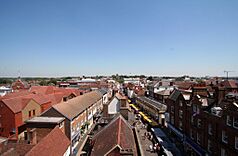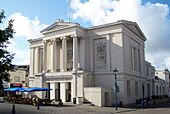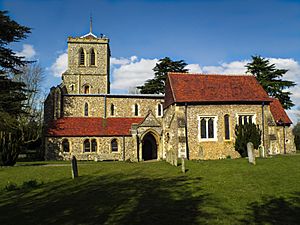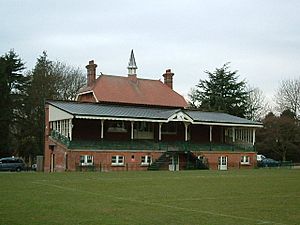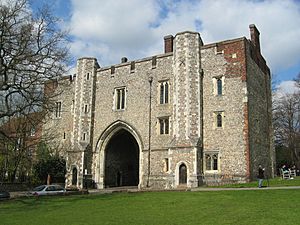St Albans facts for kids
Quick facts for kids St Albans |
|
|---|---|
| Cathedral city | |
|
|
|
 Coat of Arms |
|
| Area | 6.99 sq mi (18.1 km2) |
| Population | 82,146 |
| • Density | 11,752/sq mi (4,537/km2) |
| OS grid reference | TL148073 |
| • London | 19 mi (31 km) SSE |
| District | |
| Shire county | |
| Region | |
| Country | England |
| Sovereign state | United Kingdom |
| Post town | ST. ALBANS |
| Postcode district | AL1-AL4 |
| Dialling code | 01727 |
| Police | Hertfordshire |
| Fire | Hertfordshire |
| Ambulance | East of England |
| EU Parliament | East of England |
| UK Parliament |
|
St Albans is a cathedral city in Hertfordshire, England. It is located about 20 miles (32 km) north-west of London. St Albans was the first major town on the old Roman road called Watling Street. This road was important for travelers heading north. The city was once known as Verulamium. Today, St Albans is part of the London commuter belt. This means many people who live there travel to London for work.
Contents
The Name of St Albans
St Albans gets its name from Alban, who is known as the first British saint. His story says he lived in Verulamium during the 3rd or 4th century. This was a time when Christians were being treated badly.
Alban met a Christian priest who was trying to escape. He hid the priest in his home. Alban was so impressed by the priest's faith that he decided to become a Christian too. When the authorities came looking for the priest, Alban bravely put on the priest's cloak. He pretended to be the priest to protect his guest.
Because of this, Alban was sentenced to the same punishments as the priest. He was told he would be spared if he stopped being a Christian. Alban refused and was taken away to be executed. Legends say that after he was executed, his head rolled down a hill. A well then appeared where his head stopped.
History of St Albans
Ancient Times: Iron Age Settlement
Before the Romans arrived, there was an Iron Age settlement called Verlamion. This settlement was near where St Albans is today. It was a very important center for the Catuvellauni tribe. The name "Verlamion" means "settlement over or by the marsh."
This ancient town was on Prae Hill, about 2 km west of modern St Albans. In 1996, archaeologists found silver coins from the Roman Republic era. These coins were from 90-80 BC. This shows that people were trading with the Romans even before Julius Caesar tried to invade Britain.
Roman Verulamium
The Roman city of Verulamium grew from the Iron Age settlement. It became the second-largest town in Roman Britain, after Londinium (London). Around AD 50, Verulamium was given a special status. This meant its citizens had certain rights, though not full Roman citizenship.
In AD 61, Boudica, a queen of the Iceni tribe, attacked Verulamium. The city was burned down. Excavations in 1996-97 found a layer of black ash. This ash layer dates to AD 60-65, confirming the historical records of the fire.
Verulamium slowly grew back. By the early 3rd century, it was a large town with a deep ditch and a wall. It had important Roman buildings like a forum (a public square), a basilica (a large public building), and a theatre. These buildings were damaged by fires but were repaired and used for many years.
The body of St Alban was probably buried outside the city walls. His grave became a place where people would visit. Later, a basilica was built there. This shows it is the oldest place of continuous Christian worship in Great Britain.
Today, you can still see parts of the Roman city. These include pieces of the city walls and a hypocaust (an ancient Roman heating system). Many items from the Roman city are also on display in the museum.
Anglo-Saxon Period
After the Romans left Britain, the town became a center for the Anglo-Saxon Waeclingas tribe.
St Albans Abbey was founded on the hill outside the Roman city. This was believed to be where St Alban was buried. Even in the 8th century, the Saxon people knew about the old Roman city. They called it Verulamacæstir or Vaeclingscæstir. This name means "the fortress of the followers of Wæcla."
Medieval St Albans
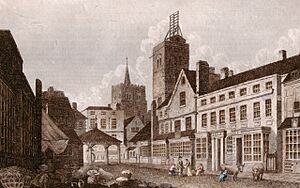
The medieval town grew on the hill east of the old Roman city. The Benedictine Abbey of St Albans was founded there in 793. St Albans Abbey was one of the most important medieval abbeys in England. Important documents, like the first draft of Magna Carta, were worked on there. After the abbey was closed in 1539, it became a parish church. In 1877, it became a cathedral.
St Albans School was founded in AD 948. It is famous for being the only school in the English-speaking world to have educated a Pope (Adrian IV).
Between 1403 and 1412, a clock tower was built in the Market Place. It is the only medieval town belfry (bell tower) still standing in England. The original bell, named Gabriel, weighs one ton. It would ring in the morning and evening.
St Albans was also the site of two battles during the Wars of the Roses. The First Battle of St Albans happened in 1455, and the Second Battle of St Albans took place in 1461.
A street market has been held in St Albans for centuries. It still takes place on Wednesdays and Saturdays.
Modern St Albans
Before the 20th century, St Albans was a small market town. It was also a place for Christian pilgrimage. Many old inns show that it was a popular stop for coaches traveling to and from London.
The railway arrived in 1858, which helped the town grow. Between 1891 and 1901, the population increased by 37%. In 1877, Queen Victoria gave St Albans city status. The former Abbey Church also became a Cathedral.
After World War II, St Albans grew quickly. Many people moved there from Greater London. Today, it is a popular place for tourists to visit.
How St Albans is Governed
St Albans has two main levels of local government. These are the St Albans City and District Council and Hertfordshire County Council. The main part of St Albans city is an area without a parish council. This means the city and district councils manage it directly.
Past Government
The town's early government was closely linked to St Albans Abbey. The abbey controlled the town for a long time. However, there were often disagreements between the abbot and the townspeople.
In 1553, the town was given a special charter by Edward VI. This made it a borough with its own mayor. In 1877, St Albans became a city.
Present Government

In 1974, the old borough was changed. St Albans became part of the new, larger St Albans City and District. The city status was then given to the entire district.
Today, local services are provided by Hertfordshire County Council and St Albans City and District Council.
Geography of St Albans
Neighborhoods
St Albans has many different neighborhoods, including:
- Batchwood
- Bernards Heath
- Chiswell Green
- Fleetville
- Marshalswick
- Sopwell
- Townsend
Nearby Towns and Villages
St Albans is surrounded by other towns and villages:
- Northwest: Redbourn
- North: Harpenden
- East: Hatfield
- Southwest: Watford
- South: Radlett
- Other nearby towns: Hemel Hempstead, Luton, Welwyn Garden City
- Nearby villages: London Colney, Park Street, Sandridge
Getting Around St Albans
Road Travel
St Albans is located near major motorways. The M1 and M25 motorways are close by. Important A-roads also serve the city. These include the A414, which connects to Hemel Hempstead and Hatfield. The A405 links to Watford.
Train Travel
St Albans has two train stations:
- St Albans City: This station is east of the city center. It has fast and frequent trains to central London via the Midland Main Line. Trains also go north to Harpenden, Luton, and Bedford.
- St Albans Abbey: This station is southwest of City station. It is the end of the Abbey line from Watford Junction.
Bus Services
St Albans has good local bus services. Buses run frequently to nearby villages and towns like Watford, Harpenden, and Luton. Different bus companies operate these routes.
Culture and Media in St Albans
St Albans has a lively cultural scene. There are many concerts and theatre shows. These take place at places like Trestle Arts Base, St Albans Abbey, and the Alban Arena. Various groups perform, including choirs and orchestras.
The Odyssey Cinema on London Road is an independent cinema. It was restored and reopened in 2014. It stands where Hertfordshire's first cinema, the Alpha Picture House, opened in 1908.

St Albans Museums runs two museums. The Verulamium Museum tells the story of Roman Britain. It uses objects found from the Roman town. The St Albans Museum + Gallery is in the old St Albans Town Hall. It focuses on the history of St Albans and Saint Alban.
Local radio stations include BBC Three Counties Radio and Heart Hertfordshire. There is also a community radio station called Mix 92.6. The local newspaper is the St Albans Observer.
Filming Location
St Albans is a popular place for filming movies and TV shows. This is because it has different types of buildings and is close to London.
- The Abbey and Fishpool Street areas were used for the TV comedy All Gas and Gaiters.
- Romeland, near the Abbey, has appeared as an Oxford college in Inspector Morse.
- The Abbey's Lady Chapel was used in the film First Knight (1995). The nave of the Abbey was used as a stand-in for Westminster Abbey in Johnny English.
- The gatehouse of the former prison appeared in the opening of the TV series Porridge.
- The film Birthday Girl (2001) was partly filmed in St Albans.
- More recently, scenes from Incendiary were filmed around the Abbey.
- In 2018, a Gucci advert with Harry Styles was filmed in Fleetville.
- Verulamium Park was used for filming Wonka in 2022.
Sports in St Albans
St Albans residents are very active in sports. A survey in 2007 showed that St Albans was one of the most active places in England.
Cricket
Clarence Park is home to St Albans Cricket Club. The club has several teams that play in local leagues. In 2008, the club's main team won the Hertfordshire League Title.
Football
The local football team is St Albans City FC. Their stadium is next to Clarence Park. The team was promoted from the Conference South League in 2005–06.
Gymnastics
St Albans Gymnastics Club started in 2005. It offers classes for fun and also has a competitive team.
Hockey
St Albans is home to St Albans Hockey Club. Both women's and men's teams play at a national level. Their nickname is The Tangerines.
Rugby League
St Albans Centurions Rugby league Club plays at Toulmin Drive. They play in the London Premier League. In 2007 and 2010, they won 'the triple'. This means they topped their league and became regional and national champions.
Rugby Union
Old Albanian RFC is a rugby union club. They play at the Old Albanian sports complex. This complex also hosts the offices of the Premiership Rugby club Saracens. St Albans RFC and Verulamians RFC also play in the area.
Skateboarding
St Albans has one of the oldest indoor skateparks in the country. The Pioneer Skatepark has ramps for skateboarders and inliners.
Other Sports Connections
St Albans was once home to Samuel Ryder. He was the person who started the famous Ryder Cup in golf. He had a successful business selling seeds. His interest in golf led him to donate the Ryder Cup. He is buried in Hatfield Road Cemetery. The Olympic Torch Relay passed by his grave in 2012 to honor him.
Education in St Albans
St Albans has many state-funded primary and secondary schools. There are also several independent (private) schools.
The law school of the University of Hertfordshire used to be in St Albans. It moved to Hatfield in 2011. The building is now part of Alban City School, a primary school.
A campus of Oaklands College, which is a college for further education, is also located in Smallford in St Albans.
International Connections
St Albans is twinned with several cities around the world. This means they have special friendly relationships. These cities include:
Notable People from St Albans
Many famous people have come from St Albans. You can find a list of them in the main article about notable people from St Albans.
Images for kids
See also
 In Spanish: St. Albans (Hertfordshire) para niños
In Spanish: St. Albans (Hertfordshire) para niños


